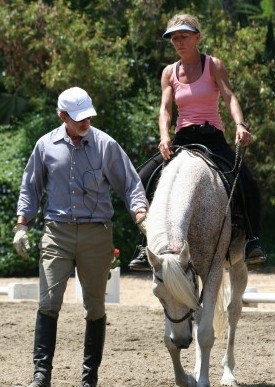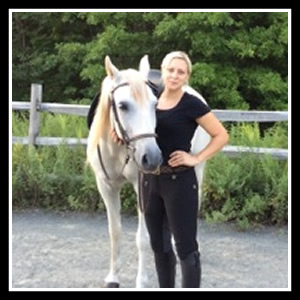How Do You Evaluate Where to Begin With a Horse/Rider You’ve Never Seen Before?
I first look at the foundation of the training and the development of the horse. If the horse is  not being ridden or worked in a manner that encourages the development of the topline (which is what I most often see) I start at the beginning. If the horse isn’t being worked correctly it will never reach its full potential so I consider this to be the number one priority. It has to be approached in a logical manner. A horse must maintain rhythm, suppleness and engagement of the topline, if it hollows the back and trails the hind legs out behind the hips you are not doing an exercise that is beneficial and can actually cause damage.
not being ridden or worked in a manner that encourages the development of the topline (which is what I most often see) I start at the beginning. If the horse isn’t being worked correctly it will never reach its full potential so I consider this to be the number one priority. It has to be approached in a logical manner. A horse must maintain rhythm, suppleness and engagement of the topline, if it hollows the back and trails the hind legs out behind the hips you are not doing an exercise that is beneficial and can actually cause damage.
What seems to be missed most often is how long it takes to correctly develop a horse and the expertise it takes. Too often trainers are trying to entertain the riders instead of doing what is best for the horse. You can not ignore the horse and focus only on the rider. Both must be taken into consideration, all of the time. The key ingredient, and the most difficult, is to always be improving the horse while in an environment that the rider can learn.
Riders and horses both take time to develop. Riders will develop a correct position in time when they become aware of how their position, balance and use of the aids affect the horse. Forcing a rider into a position they aren’t ready for leads to tension and poor use of the aids. The same applies to the horse, they can not be forced into a frame. This will lead to tension and resistance.
2 responses to “How Do You Evaluate Where to Begin With a Horse/Rider You’ve Never Seen Before?”
Leave a Reply
sounds like you know a lot about these magnificent animals.
take care, Will!
This is so true. I find with my new clients their horse more often than not have no idea how to really engage their backs.





sounds like you know a lot about these magnificent animals.
take care, Will!
This is so true. I find with my new clients their horse more often than not have no idea how to really engage their backs.